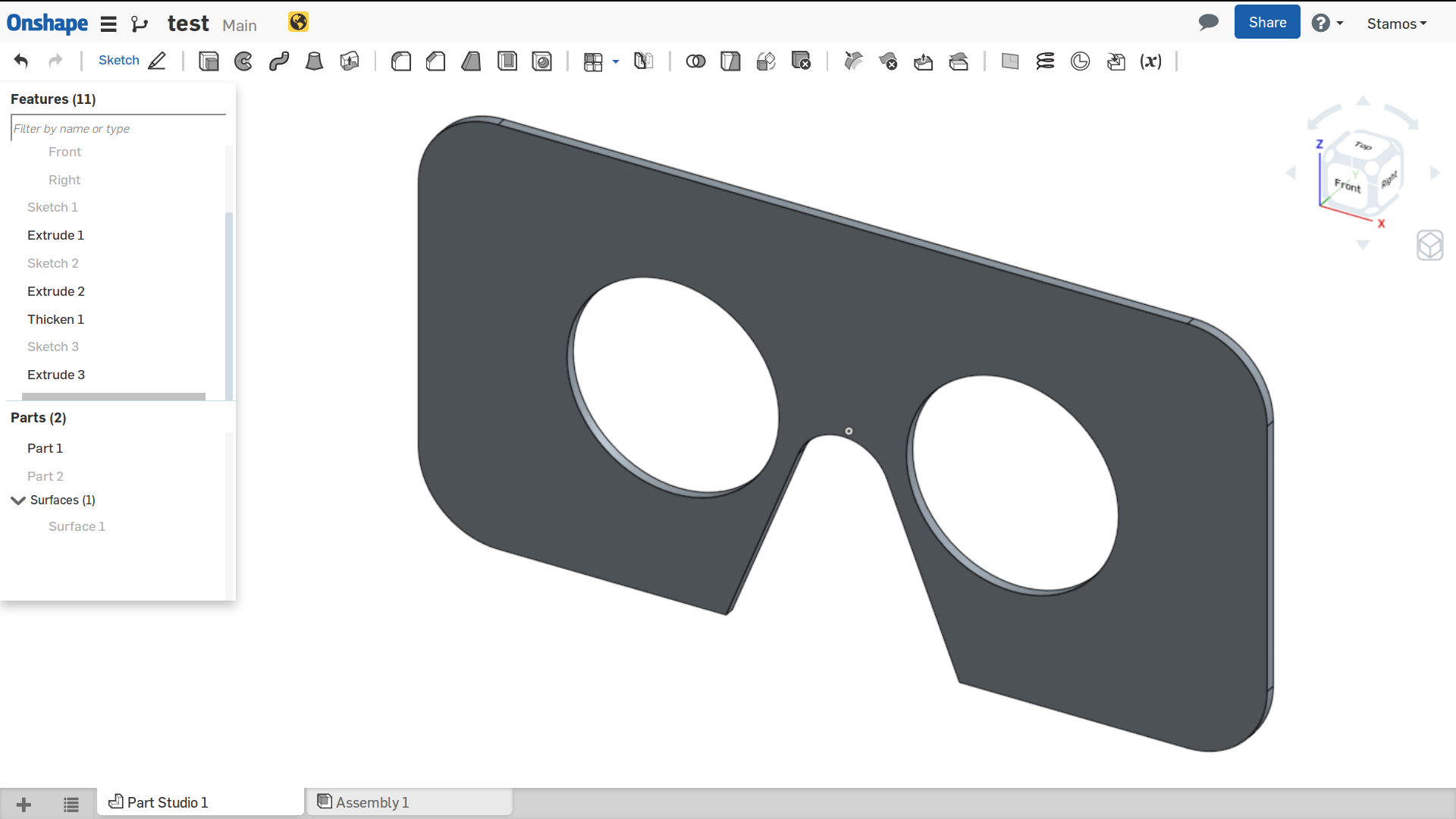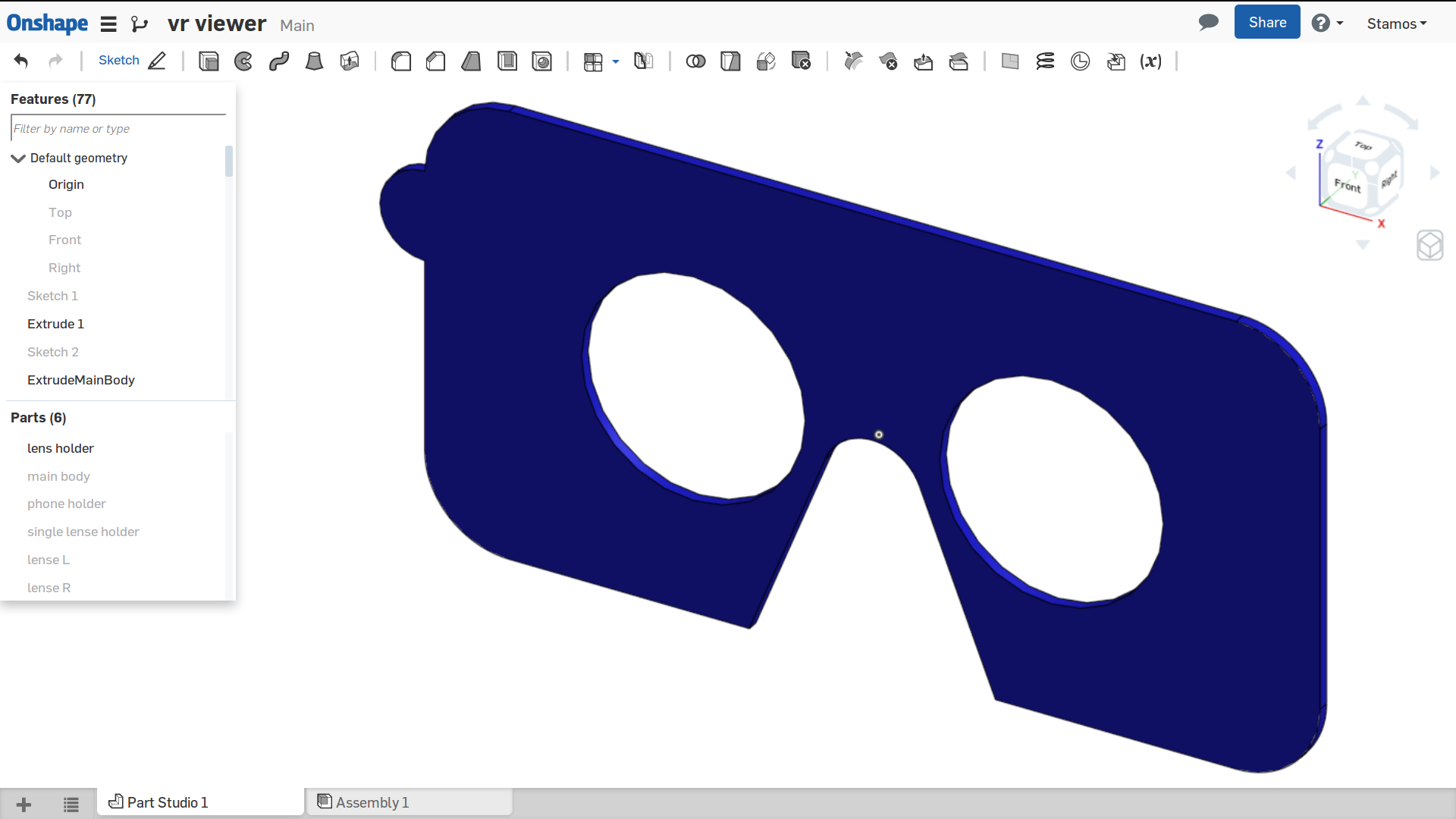Welcome to the Onshape forum! Ask questions and join in the discussions about everything Onshape.
First time visiting? Here are some places to start:- Looking for a certain topic? Check out the categories filter or use Search (upper right).
- Need support? Ask a question to our Community Support category.
- Please submit support tickets for bugs but you can request improvements in the Product Feedback category.
- Be respectful, on topic and if you see a problem, Flag it.
If you would like to contact our Community Manager personally, feel free to send a private message or an email.
Smooth Curves
 Stamos
Member Posts: 6 ✭
Stamos
Member Posts: 6 ✭
Hello, I 'm learning Onshape. When I started modeling a vr-viewer, circles and curves looked smooth. Now after many sketches and features, curves are looking like polygons. Example (notice the top left corner and the lenses holes):
At the beginning

At current state:

Am I doing something wrong? I'm not an experienced user but I did not have the same issue with Solidworks.
At the beginning

At current state:

Am I doing something wrong? I'm not an experienced user but I did not have the same issue with Solidworks.
1
Comments
-Dave_
In the current release, because chordal deviation is per part studio (and depends on the total number of triangles in the part studio, regardless of whether the part is shown or not), you can derive one part into a new part studio and (especially in your case) there is a good chance that it will be at a higher resolution.
Here is an example;
Now derive that one part into a new part studio (for screenshots etc)
Don't forget that the (Free!) rendering apps also give you control over the chordal deviation (although i did not crank it up on this one
Also (as a reward for reading this far), here is a tease of the same dataset in the next release . . . . . .
Thank you for your support of Onshape and good luck with your project!
projektowanieproduktow.wordpress.com
https://cad.onshape.com/documents/9efcb26f4bb0092bbbb2ea19/w/62e6909f1108465965aa4c36/e/fc64e4e5db2575c7b080f630
The two components have the same radius for the right side. They are actually a copy of one another with the bottom trimmed off on one.
Yet as you can see below, even in a new workspace, they have different curves.
As such I do not know if they are actually clipping through the surface of other components or if it is just a visual glitch.
Any help with this would be appreciated.
Just to make sure i understand what you're asking, here is a restatement of what i think you want -
"I understand that as a purely graphical representation, Onshape parts will always appear slightly faceted - that said i need a way to generate images with smooth arcs (especially where the radius of those arcs is large)"
If that is the correct, then your best bet for a solution today is to use one of the many rendering apps available in the app store. Many include chordal and angular deviation controls as well as other methodologies for developing that type of images you are asking for.
I hope this helps
During training, we state quite strongly that a Part Studio is used for building parts that have geometric relations between them. If there are no relations, the parts should be in separate Part Studios. This is purely for performance reasons (avoids re-generating a lot of features not related to the part you are trying to edit). Its a perfectly valid approach also to use a layout sketch in a Part Studio and build multiple related parts from that sketch, but all yours are laid flat so i dont think that was your strategy (BTW, a better way is to put the layout sketch in an assembly and then use In-Context across a number of part studios to develop the related parts - see the In-Context videos).
Is this a mostly problem is when a Part Studio has a geometry mix of large and small radius of curvature surfaces, or is the amount of geometry in a Part Studio?
This tends to be more noticeable on parts with curves that have a large radius of curvature relative to the overall part size. The angular tolerance does not help much in this situation, and the chordal tolerance may not be fine enough to make up the difference.
Now, I have this project: https://cad.onshape.com/documents/58d0eadf203be30fcdfff2c5/w/9436f156b05d9bd16bf49990/e/a923ab2cea1168d91bea12c5
It's a trivial design with just six parts but for a fairly small object, it's built with the use of large radius arcs. Until a certain point, I had no problem with how it was displayed. After adding last 8-10 features quality of tessellation dropped noticeably. I can't say if that was caused by these features or it was just correlated with some changes on your side.
Two weirdest things are, that I can rollback the bar and after rolling it forward step by step, quality of a tessellation improves:
Second weirdness is that after that "step by step" method I can close my project and after reopening it's still fine, at least for some time.
To my understatement, Onshape doesn't store data for tessellated objects and recalculates whole feature tree each time we open design.
Before I'll propose an improvement I would like to know what I'm missing.
projektowanieproduktow.wordpress.com
Similarly, each time the your design changes (either through edits, or rollback/forward) we only recalculate what is necessary to reflect that change. So when you rollback a feature, only those bits of geometry that are affected by the feature will change. This is a nice efficiency, however it can lead to variation in results because the tessellator is considering only a portion of the model, rather than the whole. This is likely why you are getting different results as you roll back and forward.
That said, the magnitude of the visual impact you are seeing is rather large, and it warrants further investigation. I would encourage you to submit feedback through the feedback tool, which can be found under the "?" menu. This will help get the issue into our issue tracking system.
Onshape I believe is completely in the dark when a user uses the mouse scroll wheel to zoom up close. If the geometry is a curved surface with a large radius of curvature you are going to see faceting. How much this "course" faceted display impedes the work flow is subjective; the data is there it is just not pretty.
What makes sense is to provide a mechanism to allow a user to request a re-tessellation of the just surfaces currently being shown in the graphic to addresses a user's display quality concerns. This new tessellation data does not have to be permanently saved in the Part Studio, let it be temporary to the browsing session.
(I appreciate the fact that Onshape does most of the work on the server side back end making it possible to run Onshape on almost any device anywhere that has a internet browser. I am curious about the possibility, if the client side has sufficient computing capacity, for Onshape to pass surface definition data and let the client do tessellation in a more dynamic manner. Going one step further, how about leveraging the power of an high end GPU to do the tessellation.)
There is work that needs to be done to give the system the flexibility to do more automatic and manual level-of-detail switching. I can't say when the work will be complete, but it is definitely on our radar.
https://forum.onshape.com/discussion/9551/improvements-to-onshape-june-15th-2018/p1